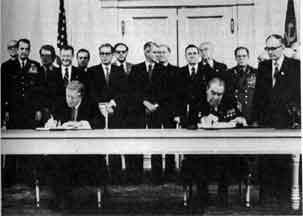1979 SALT II SIGNED

Signing SALT
The S.A.L.T. II Accord was reached in June of 1979. The Accord allowed both the US and USSR to build up to 2,250 missiles, of which 1,320 could be MIRVD (Multiple Independent Re-entry Vehicles). The MIRVD missiles could carry many warheads. The agreement was received with disdain by critics of the Soviets, who believed that the accord granted the Soviets the advantage. The S.A.L.T. II agreement was never ratified, as the subsequent Soviet invasion of Afghanistan eliminated any support for the treaty. The treaty's terms however, continued to be observed by both sides..
The SALT negotiations emerged from a shared recognition by the US and Soviet leadership that an unrestrained nuclear arms race posed a grave threat to global security. The first round of talks, known as SALT I, began in 1969 and concluded in 1972 with the signing of two agreements: the Anti-Ballistic Missile (ABM) Treaty and the Interim Agreement on Offensive Arms. The ABM Treaty limited the deployment of missile defense systems, while the Interim Agreement placed a temporary cap on the number of strategic ballistic missile launchers each side could possess. However, these agreements left many issues unresolved, necessitating further negotiations, which became known as SALT II.
Negotiations: SALT II negotiations began in November 1972 and continued for nearly seven years. The talks were complex and often contentious, reflecting the broader strategic rivalry between the US and the Soviet Union. Several key issues were on the table, including the overall number of strategic nuclear weapons, the balance between offensive and defensive systems, and restrictions on new types of weapons and technologies.
In addition to addressing the shortcomings of the SALT I agreements, the negotiators sought to establish a more comprehensive and enduring framework for strategic arms control. A major focus of the talks was on limiting the number of strategic delivery vehicles (i.e., intercontinental ballistic missiles, submarine-launched ballistic missiles, and heavy bombers) and setting ceilings on the number of warheads each side could possess.
Agreement: The SALT II Treaty was signed by US President Jimmy Carter and Soviet General Secretary Leonid Brezhnev in Vienna on June 18, 1979. The treaty aimed to build on the achievements of SALT I by establishing more comprehensive and stringent limits on strategic nuclear forces. Key provisions of the agreement included:
-
A cap on the number of strategic delivery vehicles at 2,400 for each side, with a sub-limit of 1,320 for missiles with multiple independently targetable reentry vehicles (MIRVs).
-
A prohibition on the development and deployment of new types of intercontinental ballistic missiles (ICBMs) and submarine-launched ballistic missiles (SLBMs).
-
Restrictions on the deployment of air-launched cruise missiles (ALCMs) and limits on the range and payload of these weapons.
-
Verification measures to ensure compliance with the treaty's provisions, including data exchanges, notifications of missile tests, and on-site inspections.
Implications and Legacy: Although the SALT II Treaty was signed by both parties, it faced strong opposition in the US Senate, primarily due to concerns about Soviet compliance and the adequacy of the treaty's verification measures. The ratification process was further complicated by the Soviet invasion of Afghanistan in December 1979, which led President Carter to withdraw the treaty from Senate consideration. Despite this setback, both the US and the Soviet Union voluntarily adhered to the treaty's provisions until 1986, when the Reagan administration announced that it would no longer abide by the agreement
 >
>